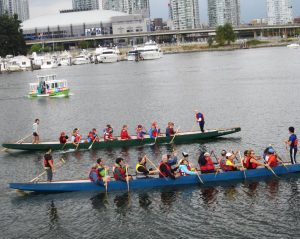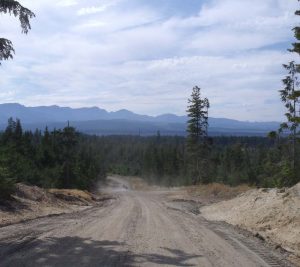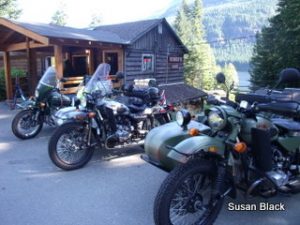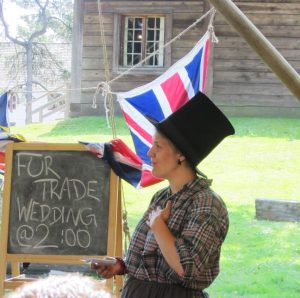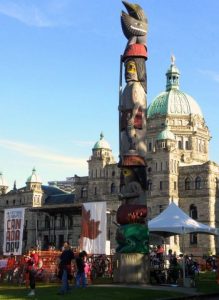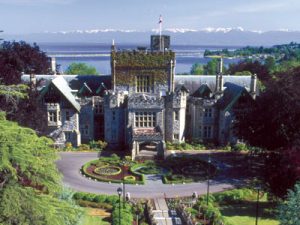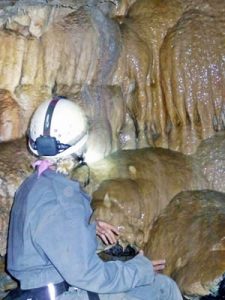by Julie H. Ferguson
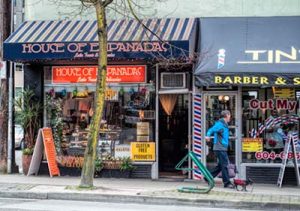
When I’m in a big city anywhere, I often avoid tourist traps by exploring a neighbourhood. The experience gets me in touch with the locals and shows me what it’s like to live there.
If you happen to be visiting multi-cultural Vancouver, many neighbourhoods offer tourists the chance for an exploratory day trip: Chinatown, Main Street, and Little India (aka Punjabi Market), to name a few. In the spring of 2013, I roamed around Denman Street in the residential West End, sandwiched by the sea at either end. It stretches from Coal Harbour in the north to English Bay in the south, with Stanley Park two blocks west. I could walk Denman one-way in about twenty minutes but I took six hours to browse the ‘hood’s funky cafés and unusual boutiques, its residential streets, and stunning beach.
The aroma of roasting coffee wafted around me as I set out on a sunny morning at Denman’s north end where motor cruisers and yachts rack up in Coal Harbour and harbour cruises depart. Between West Georgia and Robson, bike and skate rentals predominate so visitors can circle Stanley Park’s famous sea wall on a bike, choosing from the most popular electric version up to racing models. Trailers for little ones are available too.
South of Robson, the buildings are older and some, ramshackle. Here are the cafés, restaurants, and a pub or two. I lost count when I reached fifty and there must be every cuisine on the planet represented here—from the haute cuisine of Rain City Grill at the south end to a tiny spot creating homemade empanadas (Latin-style pasties), which I devoured. I ate at Kingyo’s, an unusual Japanese place just south of Haro Street, and snacked on Ukrainian perogies.
I saw few tourists here in spring. Instead Denman was full of locals walking their pint-sized Yorkies and poodles before work, and elderly residents chatting in coffee shops. Many said, “Good morning” to me, and one lady wheeling a Pug in her walker-basket stopped to chat for ten minutes. I felt like a local.
In high summer, Denman hosts Vancouver’s Pride Parade and it was no surprise to me to see some risqué stores amidst the ordinary ones. I did not explore all of these as I was solo and a bit apprehensive, but I did peek in and blush.
I reached English Bay Beach, one of many sandy beaches in the city and hugely popular. Today under cool skies, the dog walkers had displaced the sun bathers, but it is a spectacular spot to enjoy Pacific sunsets on summer evenings and sip a glass of BC chardonnay.
I’ve long loved the statues, all fourteen of them, at the corner of Denman and Davie that have graced the intersection since the Vancouver Winter Olympics. Today I enjoyed people interacting with Yue Minjun’s A-mazing Laughter, imitating them and acting the fool.
I meandered back to my hotel, Times Square Suites at Denman and Robson, through Stanley Park’s eastern edge starting at the heron rookery and ending at Lost Lagoon, where the Stanley Park Ecology Society runs children’s programs in the summer.
The Denman neighbourhood is funky, small, and friendly and very close to downtown Vancouver with all its attractions. But don’t forget Stanley Park’s Vancouver Aquarium, a ten minute bike-ride from Denman—it’s one of the best day trips for every age group.
© Julie H. Ferguson 2013
The author wishes to thank Spectacular Ink and Times Square Suites for making this exploration of the Denman Street neighborhood possible.
If you go:
- Best months to visit: anytime, but May to early October are the dry season
- Also walk east on Robson to the high-end stores like Armani and Tiffany’s.
- Thirty-fifth anniversary Pride Parade, August 4, 2013.
Tourism Vancouver: www.tourismvancouver.com.
Denman Street: www.insidevancouver.ca/2009/06/16/exploring-denman-st-from-english-bay-beach-to-coal-harbour/.
Harbour cruises: http://www.boatcruises.com/tour.php?pv=p5.
Stanley Park: http://vancouver.ca/parks-recreation-culture/stanley-park.aspx.
Vancouver Aquarium: http://www.vanaqua.org/
Bike rentals: Ezee Riders (best value at Denman and Robson) www.ezeeriders.com
Pride parade 2013: http://www.vancouverpride.ca/
Times Square Suites, ranked Vancouver’s sixth best hotel out of 97, at Denman and Robson: http://www.timessquaresuites.com.
About the author
Julie H. Ferguson is an addicted travel writer and photographer who is intensely interested in the history and culture of foreign lands, as well as Canada, and her stories and images reflect this focus. She never leaves home without her cameras and voice recorder, always looking for the colour and sounds that captivate readers everywhere.
Julie is also the author of twenty-six books, including four about Canadian history and seventeen travel-photo portfolios. Her travel articles and images have appeared in global markets, both print and online.
She invites you to visit her travelog www.stampsinmypassport.blogspot.com, her website at www.beaconlit.com, and her portfolio at www.flickr.com/photos/beaconlit.
© Photo by Pharos (Julie H. Ferguson) 2013
